
The Pieridae are a large family of butterflies with about 76 genera containing about 1,100 species, mostly from tropical Africa and tropical Asia with some varieties in the more northern regions of North America and Eurasia. Most pierid butterflies are white, yellow, or orange in coloration, often with black spots. The pigments that give the distinct coloring to these butterflies are derived from waste products in the body and are a characteristic of this family. The family was created by William John Swainson in 1820.
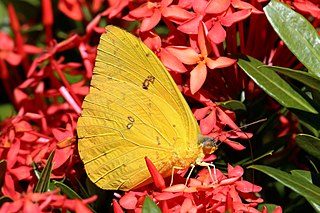
Phoebis sennae, the cloudless sulphur, is a mid-sized butterfly in the family Pieridae found in the Americas. There are several similar species such as the yellow angled-sulphur, which has angled wings, statira sulphur, and other sulphurs, which are much smaller. The species name comes from the genus Senna to which many of the larval host plants belong.

Gonepteryx rhamni, commonly named the common brimstone, is a butterfly of the family Pieridae. It lives throughout the Palearctic zone and is commonly found across Europe, Asia, and North Africa. Across much of its range, it is the only species of its genus, and is therefore simply known locally as the brimstone. Its wing span size is 60–74 mm (2.4–2.9 in). It should not be confused with the brimstone moth Opisthograptis luteolata.

Coliadinae, the sulphurs or yellows, are a subfamily of butterflies with about 300 described species.

Colias croceus, clouded yellow, is a small butterfly of the family Pieridae, the yellows and whites.

Colias chrysotheme, the lesser clouded yellow, is a small Palearctic butterfly belonging to the family Pieridae.

Colias is a genus of butterflies in the family Pieridae. They are often called clouded yellows in the Palearctic and sulphurs in North America. The closest living relative is the genus Zerene, which is sometimes included in Colias.

Colias philodice, the common sulphur or clouded sulphur, is a North American butterfly in the family Pieridae, subfamily Coliadinae.

Senna marilandica, commonly known as Maryland senna, Maryland wild senna, and wild senna, is a perennial flowering plant in the pea family (Fabaceae) native to the United States. It blooms in the summer with yellow flowers, followed by long seed pods, and can grow up to 2 m (6 ft) tall. It prefers average to wet soil.

Kricogonia lyside, the lyside sulphur or guayacan sulphur, is a North American, Caribbean, and South American butterfly in the family Pieridae.

Many populations of Lepidoptera migrate, sometimes long distances, to and from areas which are only suitable for part of the year. Lepidopterans migrate on all continents except Antarctica, including from or within subtropical and tropical areas. By migrating, these species can avoid unfavorable circumstances, including weather, food shortage, or over-population. In some lepidopteran species, all individuals migrate; in others, only some migrate.
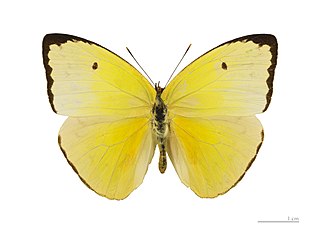
Aphrissa is a genus of butterflies in the family Pieridae found in Central and South America.
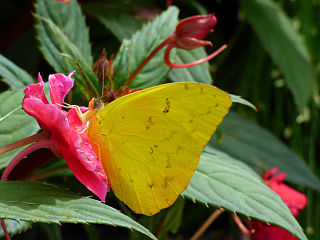
Phoebis philea, the orange-barred sulphur, is a species of butterfly found in the Americas including the Caribbean.
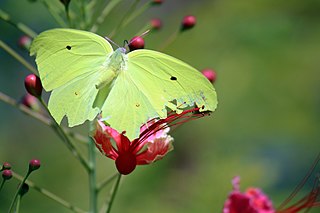
Anteos maerula, the angled sulphur or yellow angled-sulphur, is a butterfly of the family Pieridae. It is found from Peru to Mexico. Rarely, migrants can be found up to eastern Nebraska, south-eastern Arizona, south-western New Mexico, southern Texas, Mississippi and Florida.

Phoebis agarithe, the large orange sulphur, is a butterfly in the family Pieridae. It is found from Peru north to southern Texas and peninsular Florida. Rare strays can be found up to Colorado, South Dakota, Wisconsin, and New Jersey. The species has also been introduced in Hawaii. The habitat consists of open, tropical lowlands including gardens, pastures, road edges, trails and parks.

Aphrissa orbis, the orbed sulphur, is a butterfly in the family Pieridae. It is native to Hispaniola and Cuba but is a very rare stray to Florida. The habitat consists of tropical moist forests above 500 meters.

Rhabdodryas is a genus of butterflies in the family Pieridae. The only species is the straight-line sulphur.
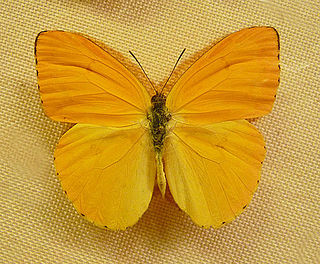
Phoebis argante, the apricot sulphur or Argante giant sulphur, is a butterfly in the family Pieridae.

Anteos menippe, the great orange tip or orange-tipped angled-sulphur, is a neotropical butterfly of the family Pieridae.























